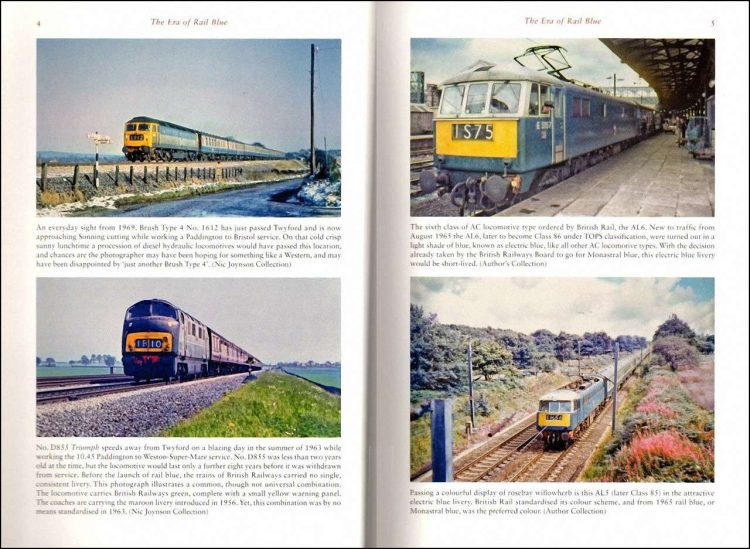Published by Amberley Publishing in July 2022 and written by Mark Jamieson, this softcover book comes in the usual Amberley format of around 234 mm x 165 mm with 96 pages and 180 colour photographs. It has a published price of £15.99, but can be purchased online from Amberley Publishing for £14.39 or from Amazon for £8.36.
For many years, in the early days of the motor car, Henry Ford declared that buyers of Ford motor cars could have them in any colour they liked, so long as it was black. So it was with British Rail from the mid-1960s to the early-1990s, where all locomotives and rolling stock had to be painted in electric blue or to use the official term for the chosen shade, Monastral Blue.
In a very brief introduction, the author describes how rail blue came to be chosen as the standard for all British Rail's rolling stock. There follows the bulk of the book in which there are no chapters, but a purely a photographic appreciation of that time on our railways.
The author has included photographs depicting trains in rail blue across the whole of the UK, from Penzance in the far southwest to Wick in northern Scotland. In a book of this nature, it would have been too easy to include a monotonous selection of similar subjects, but the author has done well to include a large variety of freight and passenger duties, albeit with rail blue at their heart.
Although some photographs show how the blue often lost its pristine appearance, in general, most of the photographs in the book show the locomotives and trains in a presentable appearance.
The book is titled The Era of Rail Blue, yet the lower photo on the left, just the second photo in the book, shows a green locomotive hauling a set of maroon coaches.

There are several pages in the book where the choice of layout is less than optimum. All photos on the right-hand page below would benefit if one of them were printed in the unused blank space on the left.
A number of captions seem to be incomplete, such as the one at the lower left showing 31456 as being 53 miles into a 77-mile journey, but no hint where it was travelling from or to. On another page, the caption states that there don't appear to be many people travelling on the train that day, even though the occupants of the carriages cannot be discerned.
There are a number of basic errors in the book, such as the caption at top-left below that states the driver is telephoning the signalman at Old Oak Common, which would never happen as Old Oak Common was an engine shed, and there were several signal boxes between there and Paddington.
A number of captions in the book refer to particular locos being synonymous with certain places. In this case, the caption at lower-left refers to Newcastle being synonymous with Class 03 shunters; the same occurs at the top of page 52 with reference to Norwich. That may have been true in the Rail Blue era, but for many more years, Newcastle station would have been home to ex-LNER tank engines of classes J67 and J69.
In summary, this book is a nostalgic look back at the time when there was a semblance of commonality in the appearance of trains on Britain's railways. Some may argue that they were the better for it, compared with the hotch-potch of liveries that are seen on today's railways. This book is recommended for anyone who has fond memories of the rail blue era, or was not around to experience an endless stream of trains in similar liveries.
The book is available to purchase from Amazon for around £8.36.
We would like to thank Amberley Publishing for providing RailAdvent with a copy of the book for review.